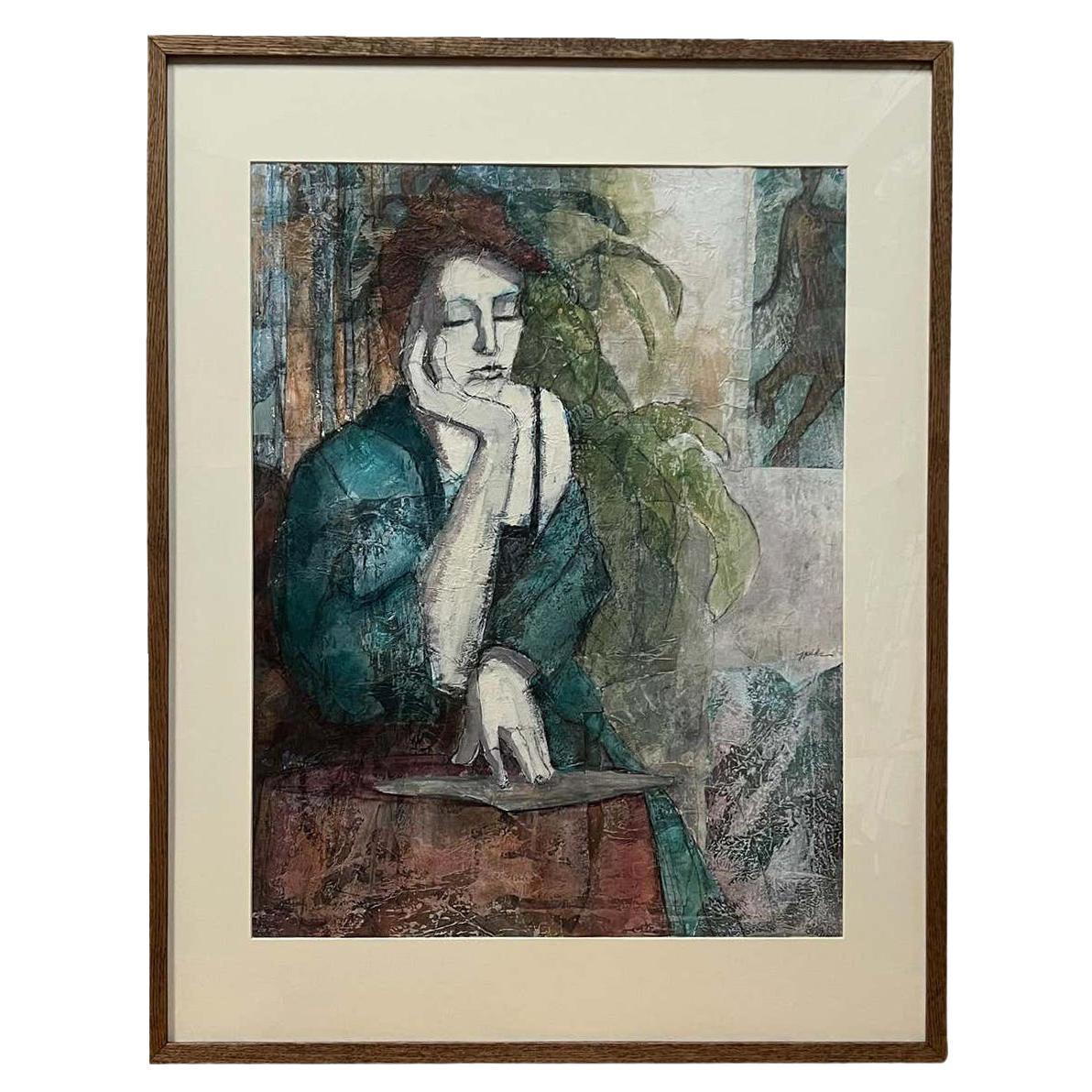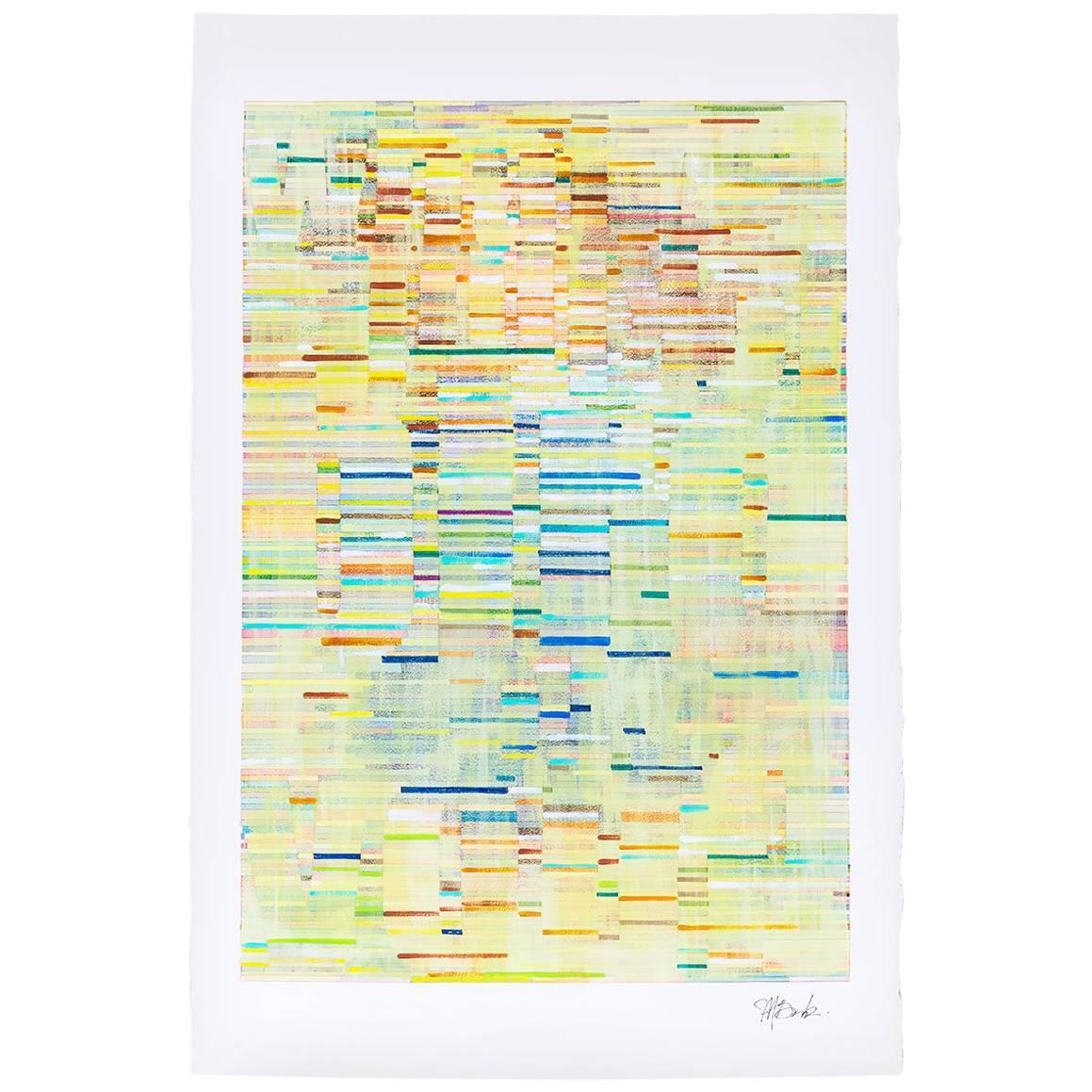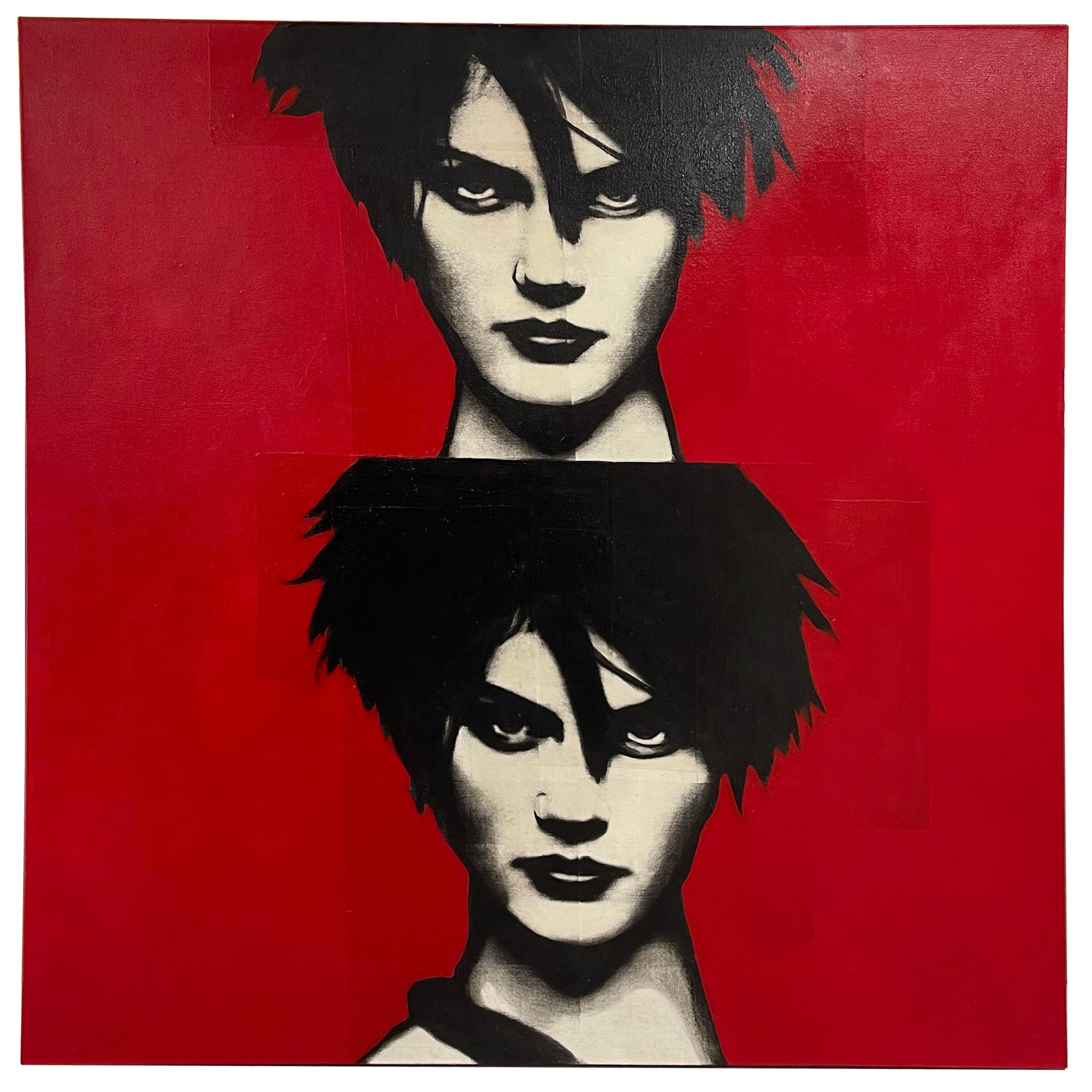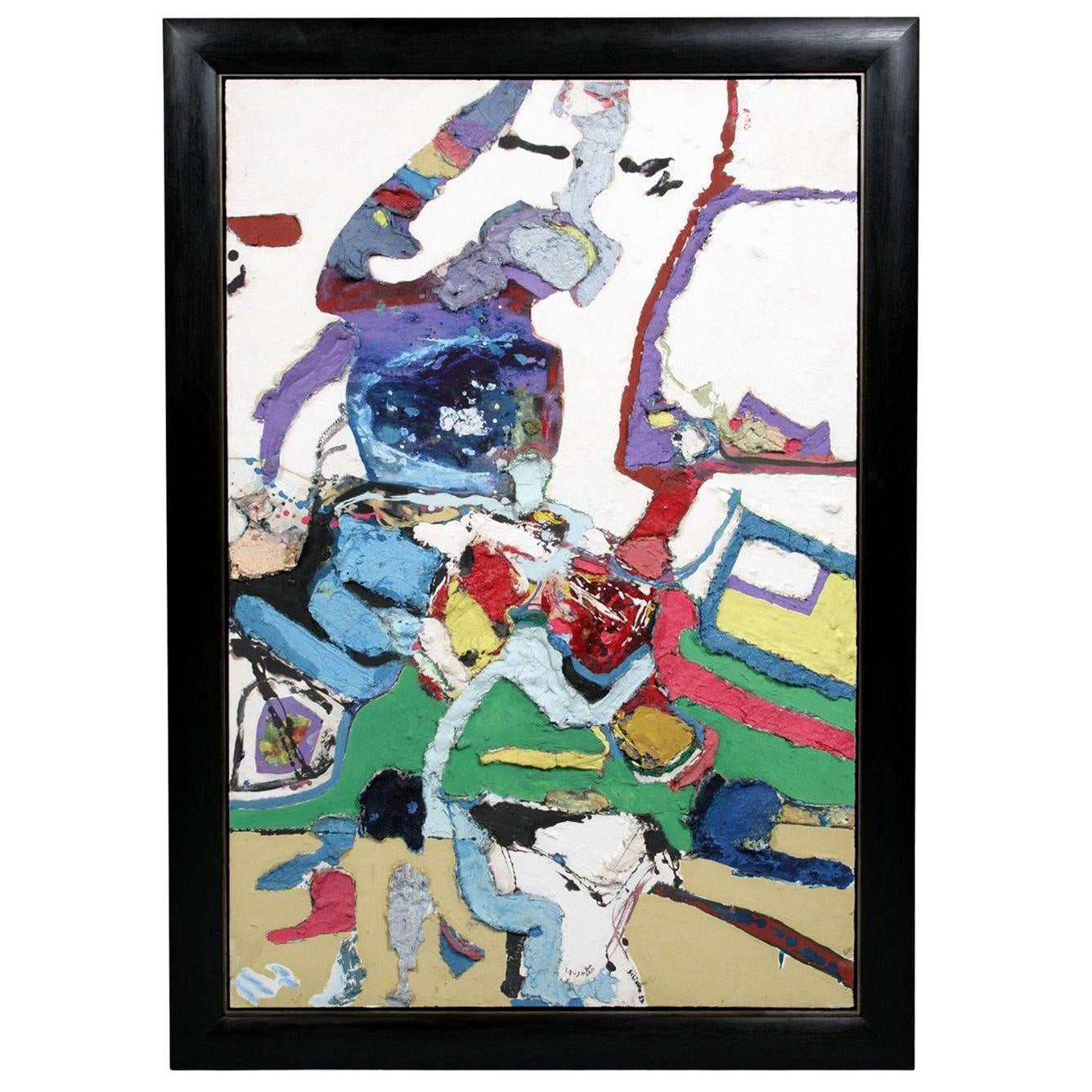Items Similar to Mixed Media Portrait #3 by Judy Pike
Want more images or videos?
Request additional images or videos from the seller
1 of 10
Mixed Media Portrait #3 by Judy Pike
About the Item
Judith Minna Pike
December 19, 1942- October 18, 2019
This portrait made using a combination of unblending and blending pastels gives this work greater variety, softer edges, and more unified areas of light and shadow.
The woman is seen casually sitting in a vibrant orange chair. I love the complementary color palette used by Pike in this piece.
Judy taught Spanish at Lincoln High School for a short time after college, but art would become her life-long passion. She experimented with clay and reiki pottery for several years but eventually transitioned to watercolor, oil painting, mixed media, and figurative drawings for the majority of her career.
In an artist’s statement around one of her solo shows featuring a group of mixed-media figurative pieces, Judy discussed her creative process.
'We are all more than one thing,’ said Judy, who encourages her models to play with different personas when they pose. ‘People are complicated and that’s what I try to capture in my work. Gestures, features, mood, clothing, choice, and facial expressions make a model unique and drawing becomes a conversation between the model and the artist. As I add layers, my goal is to clarify and deepen that conversation, revealing the model as an individual, not just a type.’”
An award-winning artist and juror, Judy’s work often drew on inspiration from family photos, both from her childhood and later years. Her art has been exhibited in several solo and group shows, including four featured exhibitions at the San Diego Institute of Art. In 2003, she was featured in Watercolor Magic Magazine Yearbook “Ones to Watch.”
Judy co-founded the Figurative Inspiration Group (FIG) in 2006, with the aim of creating a space for a unique collaboration between models and artists. She was an active member of the West Coast Drawing Group and curated a monthly art show at Adam’s Avenue Grille for several years.
- Dimensions:Height: 36.13 in (91.78 cm)Width: 26.13 in (66.38 cm)Depth: 1.38 in (3.51 cm)
- Materials and Techniques:
- Place of Origin:
- Period:
- Date of Manufacture:1990
- Condition:New framing.
- Seller Location:Pasadena, CA
- Reference Number:1stDibs: LU825827276672
About the Seller
4.8
Vetted Seller
These experienced sellers undergo a comprehensive evaluation by our team of in-house experts.
Established in 2000
1stDibs seller since 2006
496 sales on 1stDibs
Typical response time: 3 hours
Associations
20th Century Specialists
- ShippingRetrieving quote...Ships From: Pasadena, CA
- Return PolicyA return for this item may be initiated within 3 days of delivery.
More From This SellerView All
- Mixed Media Portrait #2 by Judy PikeLocated in Pasadena, CAJudith Minna Pike December 19, 1942- October 18, 2019 Mixed media painting of a young thoughful woman, sitting comfortably. Pike used many different brush techniques when painting...Category
1990s American Paintings
MaterialsPaper
- Mixed Media Portrait #1 by Judy PikeLocated in Pasadena, CAJudith Minna Pike December 19, 1942- October 18, 2019 Portrait of a woman sitting with her eyes closed, resting her head on her hand. The texture of this piece is stunning. If y...Category
Late 20th Century American Modern Paintings
MaterialsPaper
- "Woman and Her Cat" Mixed Media Artwork by Rupert PicottBy Rupert PicottLocated in Pasadena, CAThe work is a lively portrayal of an African nude woman in her bedroom. Under the bed, a discontent cat harbors grudges against its owner robbing its yellow cushion. The painting is ...Category
Late 20th Century Senegalese Modern Paintings
MaterialsAcrylic, Paper
- Mixed-Media Abstract Oil on Canvas by Cuban Artist Antonio DojerLocated in Pasadena, CAAn abstraction is a powerful tool that allows artists to question reality, challenge our understanding of the world, and expand our horizons beyond what we can see and touch. In this square format piece combining collage and painting, the artist - a romantic visual poet - is aware that all design is inspired by the Natural that gives life to thoughts in a way that is open to interpretation and subjective experience. Different shapes, round, cubic forms, line and strokes obtained by scratching, textures, words cut presented backward as a mystery that can be pierced. Through a process of cutting, layering, and highlighting, the artist imbues the materials and colors with deeper meaning. At the bottom, a grounded and strong base is strengthened by dark colors and the absence of forms and details. This technique of creating a sense of energy and motion within an otherwise static composition is fully mastered in this artwork. The composition's towering and upright shapes naturally guide the viewer's gaze upwards, creating a dynamic interplay between spiritual themes and verticality. Born in Havana in 1971, Antonio Dojer’s abstract work reflects the colorful culture, vibrant community, and often tumultuous social environment of his native Cuba. Yearning to create and express beyond the political rigidity of his country, Dojer went on to study at the San Alejandro School of Art in Spain...Category
1990s Paintings
MaterialsCanvas
- Androgynous Pastel Portrait by Gillian LefkowitzLocated in Pasadena, CAPortrait of an androgynous figure. Through a dramatic and expressive color palette, Lefkowitz showcases so much emotion in her portraits. Her artw...Category
Early 2000s American Modern Paintings
MaterialsWood, Paper
- Woman Pastel Portrait by Gillian LefkowitzLocated in Pasadena, CAPastel portrait of a woman by Gillian Lefkowitz. Her portraits are known to convey the mood of the person she painted. After her career as a professional photographer and Fine Art painter, Gillian became a Los Angeles-based interior decorator.Category
Early 2000s American Modern Paintings
MaterialsWood, Paper
You May Also Like
- "Self-Portrait" Original Contemporary Art Mixed Media PaintingBy Johanna BoccardoLocated in Mexico City, MXThis vibrant original painting by Miami based artist, Johanna Boccardo, was created with the meticulous signature style of the artist. The painting boldly displays her chromatic mast...Category
2010s American Post-Modern Contemporary Art
MaterialsPaper
- Mixed Media by Scott KerrLocated in Dallas, TXScott Kerr is a self-taught Contemporary Abstract Artist. As a young boy, he was exposed to the art world by his father through the works of a local Texas artist, David Brownlow. Ama...Category
21st Century and Contemporary Mid-Century Modern Paintings
MaterialsCanvas, Paint
- Graphic Mixed MediaLocated in Palm Springs, CAA stunning graphic mixed media on canvas with two portrait busts in red black and white. It is signed and dated on the back 2004. We cannot make out the name of the artist. The image...Category
Early 2000s American Paintings
MaterialsPaint
- Mixed-Media Painting by Louis SchiavoBy Louis SchiavoLocated in London, GBMixed-media on board on gesso ground, in gouache and oil using the impasto technique. The work also includes areas of collage using applied materials beneath the paint to add depth ...Category
Vintage 1950s Corsican Mid-Century Modern Paintings
MaterialsCanvas
- Mixed Media Painting by Steven ColucciBy Jackson PollockLocated in New York City, NYSteven Colucci’s iconoclastic approach to performance and the visual arts have not only long blurred the boundaries between these disciplines, but have challenged its most basic assumptions. The title of this show references a most rudimentary dance move --the plié --and our assumptions of what to expect in relation to this. Also the suggestion that we can simply press a button and a preconceived outcome will be courteously delivered --a form of prefabricated belief in itself. Steven Colucci’s artwork turns such basic assumptions on their heads. Finding early inspiration in the New York school of abstract expressionists such as Jackson Pollock with his action painting, and then further by his professor --a then young Vito Acconci while studying at the School of Visual Arts, Steven Colucci went from exploring the raw existentialist experimentation of New York’s early painting and performance scenes, to investigating the other end of the spectrum --the rigorously measured and controlled disciplines of pantomime and ballet; studying in Paris under the tutelage of world-famous Marcelle Marceau, and engaging with the concepts of dramatic movement pioneer and intellectual Etienne Decroux. Colucci has explained the difference between the extremes of pantomime and dance as being that pantomime forces movement via an internal capacity --movement directed inward to the core of one’s self --a source requiring extreme mental and physical control. Dance by contrast is an external expression; likewise requiring great precision, although instead an extension of self or sentiment that projects outwardly. While such historical ‘movement’ disciplines serve as foundation blocks for Steven’s artistic explorations, it is the realm in between that he is best known for his contributions --an experimental movement and performance art that simultaneously honors, yet defiantly refutes tradition; rejecting a compartmentalization regarding art and movement, yet incorporating its elements into his own brand of experimental pastiche. Colucci’s performance works manifest as eerily candy-coated and familiar, yet incorporate unexpected jags of the uncanny throughout, exploiting a sort of coulrophobia in the viewer; an exploration of a cumulative artifice that binds human nature against its darker tendencies; highlighting traditions of artifice itself - the fabricated systemologies that necessitate compartmentalization in the first place. It is evident in Steven Colucci’s paintings that he has established a uniquely distinctive pictorial vocabulary; a strong allusion to --or moreso an extension of --his performance works. Colucci’s paintings depict a sort of kinetic spectrum, or as he refers to them “a technical expression of physicality and movement”. Whereas the French performance and visual artist Yves Klein used the human body as a “paint brush” to demarcate his paintings and thereby signify a residue of performance, Colucci’s utilization of nonsensical numbers and number sequences taken from dance scores, as well as heat- induced image abstraction depicting traces of movement likewise inform his vocabulary. In the strand of the choreographed, yet incorporating moments of chance, Colucci’s paintings represent an over arching structure; a rhythm of being and state, yet detail erratic moments --moments that denote a certain frailty --the edge of human stamina. Colucci’s paintings dually represent a form of gestural abstraction --and also the reverse of this --a unique anthropomorphization of varying states of movement – that sometimes present as a temperature induced color field, at others are juxtapositions of movement and depictions of physical gestural images themselves. Colucci’s use of vernacular and found materials such as cardboard evoke his mastery of set design, and also reference a sort of collective experience of urbanity and the ephemeral. Such contradictions seem to permeate not only Steven Colucci’s artwork, but also are reflected in his person – one who grew up in New York’s Bronx during a zeitgeist moment in visual and performing arts in the 1960s – one who shifts with ease from happenings and experiments in New York City, to his meticulously choreographed megaproductions at Lincoln Center or starring in the Paris ballet...Category
2010s Paintings
MaterialsAcrylic
- Mixed Media Painting by Steven ColucciBy John ByardLocated in New York City, NYSteven Colucci’s iconoclastic approach to performance and the visual arts have not only long blurred the boundaries between these disciplines, but have challenged its most basic assumptions. The title of this show references a most rudimentary dance move --the plié --and our assumptions of what to expect in relation to this. Also the suggestion that we can simply press a button and a preconceived outcome will be courteously delivered --a form of prefabricated belief in itself. Steven Colucci’s artwork turns such basic assumptions on their heads. Finding early inspiration in the New York school of abstract expressionists such as Jackson Pollock with his action painting, and then further by his professor --a then young Vito Acconci while studying at the School of Visual Arts, Steven Colucci went from exploring the raw existentialist experimentation of New York’s early painting and performance scenes, to investigating the other end of the spectrum --the rigorously measured and controlled disciplines of pantomime and ballet; studying in Paris under the tutelage of world-famous Marcelle Marceau, and engaging with the concepts of dramatic movement pioneer and intellectual Etienne Decroux. Colucci has explained the difference between the extremes of pantomime and dance as being that pantomime forces movement via an internal capacity --movement directed inward to the core of one’s self --a source requiring extreme mental and physical control. Dance by contrast is an external expression; likewise requiring great precision, although instead an extension of self or sentiment that projects outwardly. While such historical ‘movement’ disciplines serve as foundation blocks for Steven’s artistic explorations, it is the realm in between that he is best known for his contributions --an experimental movement and performance art that simultaneously honors, yet defiantly refutes tradition; rejecting a compartmentalization regarding art and movement, yet incorporating its elements into his own brand of experimental pastiche. Colucci’s performance works manifest as eerily candy-coated and familiar, yet incorporate unexpected jags of the uncanny throughout, exploiting a sort of coulrophobia in the viewer; an exploration of a cumulative artifice that binds human nature against its darker tendencies; highlighting traditions of artifice itself - the fabricated systemologies that necessitate compartmentalization in the first place. It is evident in Steven Colucci’s paintings that he has established a uniquely distinctive pictorial vocabulary; a strong allusion to --or moreso an extension of --his performance works. Colucci’s paintings depict a sort of kinetic spectrum, or as he refers to them “a technical expression of physicality and movement”. Whereas the French performance and visual artist Yves Klein used the human body as a “paint brush” to demarcate his paintings and thereby signify a residue of performance, Colucci’s utilization of nonsensical numbers and number sequences taken from dance scores, as well as heat- induced image abstraction depicting traces of movement likewise inform his vocabulary. In the strand of the choreographed, yet incorporating moments of chance, Colucci’s paintings represent an over arching structure; a rhythm of being and state, yet detail erratic moments --moments that denote a certain frailty --the edge of human stamina. Colucci’s paintings dually represent a form of gestural abstraction --and also the reverse of this --a unique anthropomorphization of varying states of movement – that sometimes present as a temperature induced color field, at others are juxtapositions of movement and depictions of physical gestural images themselves. Colucci’s use of vernacular and found materials such as cardboard evoke his mastery of set design, and also reference a sort of collective experience of urbanity and the ephemeral. Such contradictions seem to permeate not only Steven Colucci’s artwork, but also are reflected in his person – one who grew up in New York’s Bronx during a zeitgeist moment in visual and performing arts in the 1960s – one who shifts with ease from happenings and experiments in New York City, to his meticulously choreographed megaproductions at Lincoln Center or starring in the Paris ballet...Category
2010s Paintings
MaterialsAcrylic
Recently Viewed
View AllMore Ways To Browse
Vintage Clothing Inspiration
Retro Wall Watch
Vintage Casual Chair
Vintage Grille
Vintage Grilles
Complicated Watches
Fig Chair
Pike Oil
Watch 1942
San Diego Watches
Avenue Watches
Avenue Watch
Spanish Pottery 20th Century
Vintage College Clothing
Vintage Pike
Solo Watch Vintage
Pastel Pottery
Vintage Judys Clothing





